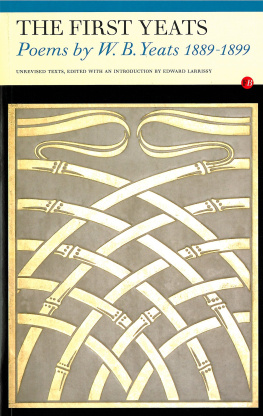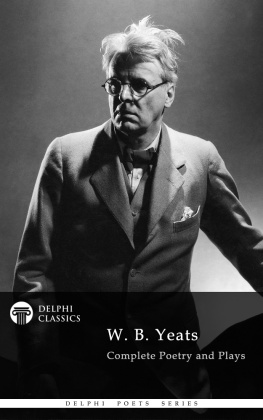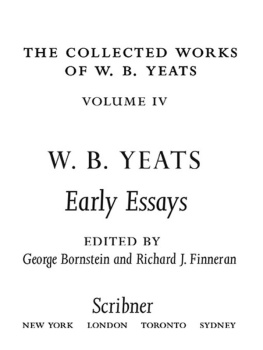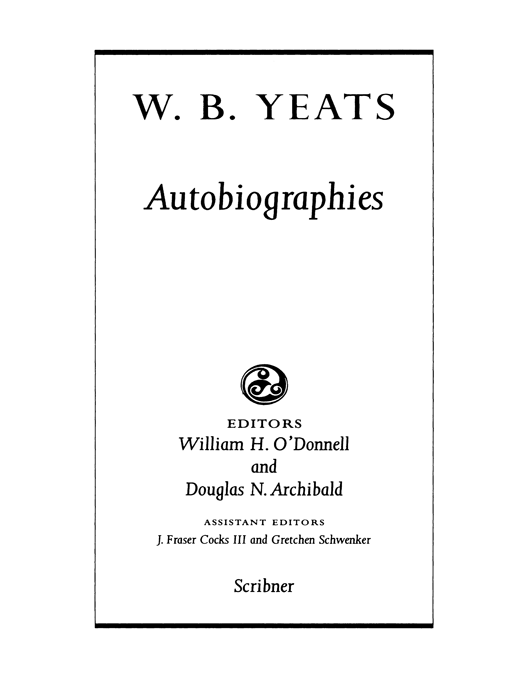William Butler Yeats - Autobiographies: The Collected Works of W.B. Yeats, Volume III
Here you can read online William Butler Yeats - Autobiographies: The Collected Works of W.B. Yeats, Volume III full text of the book (entire story) in english for free. Download pdf and epub, get meaning, cover and reviews about this ebook. City: New York, Ireland, year: 1989/9999, publisher: Simon & Schuster;Scribner;Macmillan, genre: Art. Description of the work, (preface) as well as reviews are available. Best literature library LitArk.com created for fans of good reading and offers a wide selection of genres:
Romance novel
Science fiction
Adventure
Detective
Science
History
Home and family
Prose
Art
Politics
Computer
Non-fiction
Religion
Business
Children
Humor
Choose a favorite category and find really read worthwhile books. Enjoy immersion in the world of imagination, feel the emotions of the characters or learn something new for yourself, make an fascinating discovery.

- Book:Autobiographies: The Collected Works of W.B. Yeats, Volume III
- Author:
- Publisher:Simon & Schuster;Scribner;Macmillan
- Genre:
- Year:1989/9999
- City:New York, Ireland
- Rating:5 / 5
- Favourites:Add to favourites
- Your mark:
Autobiographies: The Collected Works of W.B. Yeats, Volume III: summary, description and annotation
We offer to read an annotation, description, summary or preface (depends on what the author of the book "Autobiographies: The Collected Works of W.B. Yeats, Volume III" wrote himself). If you haven't found the necessary information about the book — write in the comments, we will try to find it.
The Collected Works of W. B. Yeats, Volume III: Autobiographies is part of the fourteen-volume series overseen by eminent Yeats scholars Richard J. Finnerah and George Mills Harper. The series includes virtually all of the Nobel laureates published work, with authoritative and explanatory notes.
Autobiographies consists of six autobiographical works -- Reveries Over Childhood and Youth, The Trembling of the Veil, Dramatis Personae, Estrangement, The Death of Synge, and The Bounty of Sweden -- that William Butler Yeats published together in the mid-1930s to form a single, extraordinary memoir of the first fifty-eight years of his life, from his earliest memories of childhood to winning the Nobel Prize for Literature. This volume provides a vivid series of personal accounts of a wide range of figures, and it describes Yeatss work as poet and playwright, as a founder of Dublins famed Abbey Theatre, his involvement with Irish nationalism, and his fascination with occultism and visions. This book is most compelling as Yeatss own account of the growth of his poetic imagination. Yeats thought that a poet leads a life of allegory, and that his works are comments upon it. Autobiographies enacts his ruling belief in the connections and coherence between the life that he led and the works that he wrote. It is a vision of personal history as art, and so it is the one truly essential companion to his poems and plays.
Edited by William H. ODonnell and Douglas N. Archibald, this volume is available for the first time with invaluable explanatory notes and includes previously unpublished passages from candidly explicit first drafts
William Butler Yeats: author's other books
Who wrote Autobiographies: The Collected Works of W.B. Yeats, Volume III? Find out the surname, the name of the author of the book and a list of all author's works by series.









